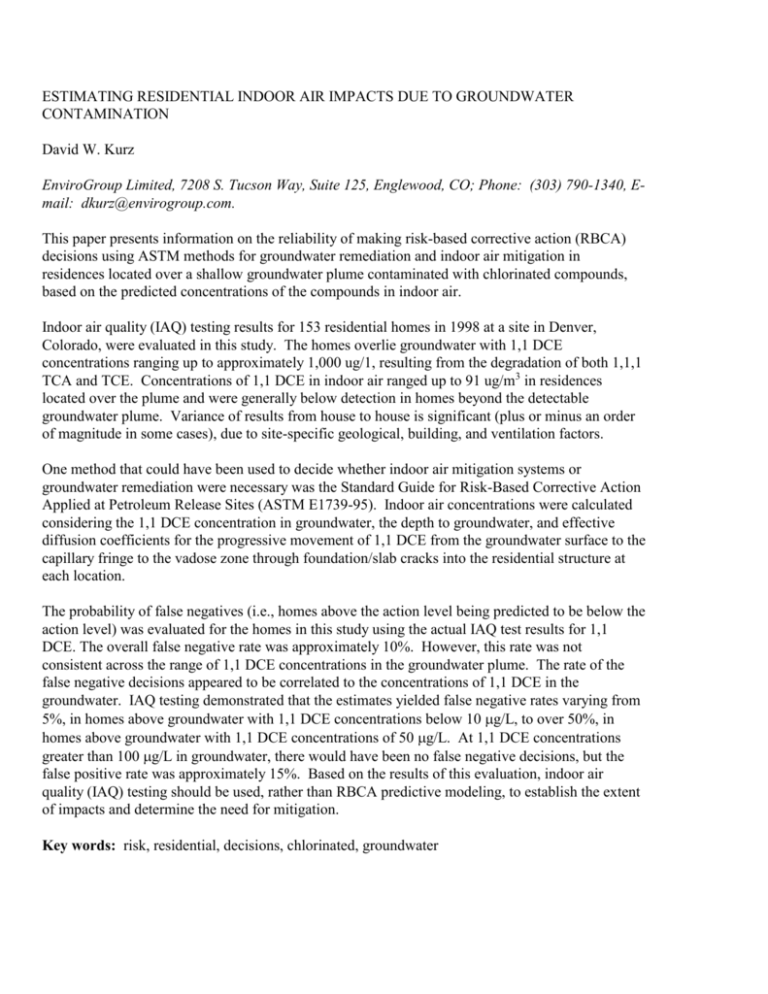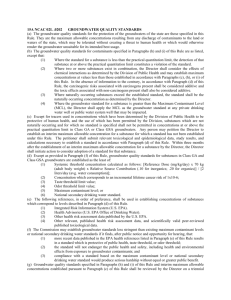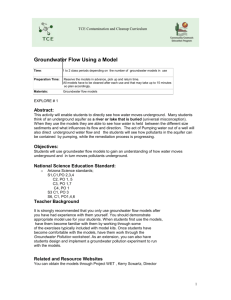estimating residential indoor air impacts due to groundwater
advertisement

ESTIMATING RESIDENTIAL INDOOR AIR IMPACTS DUE TO GROUNDWATER CONTAMINATION David W. Kurz EnviroGroup Limited, 7208 S. Tucson Way, Suite 125, Englewood, CO; Phone: (303) 790-1340, Email: dkurz@envirogroup.com. This paper presents information on the reliability of making risk-based corrective action (RBCA) decisions using ASTM methods for groundwater remediation and indoor air mitigation in residences located over a shallow groundwater plume contaminated with chlorinated compounds, based on the predicted concentrations of the compounds in indoor air. Indoor air quality (IAQ) testing results for 153 residential homes in 1998 at a site in Denver, Colorado, were evaluated in this study. The homes overlie groundwater with 1,1 DCE concentrations ranging up to approximately 1,000 ug/1, resulting from the degradation of both 1,1,1 TCA and TCE. Concentrations of 1,1 DCE in indoor air ranged up to 91 ug/m3 in residences located over the plume and were generally below detection in homes beyond the detectable groundwater plume. Variance of results from house to house is significant (plus or minus an order of magnitude in some cases), due to site-specific geological, building, and ventilation factors. One method that could have been used to decide whether indoor air mitigation systems or groundwater remediation were necessary was the Standard Guide for Risk-Based Corrective Action Applied at Petroleum Release Sites (ASTM E1739-95). Indoor air concentrations were calculated considering the 1,1 DCE concentration in groundwater, the depth to groundwater, and effective diffusion coefficients for the progressive movement of 1,1 DCE from the groundwater surface to the capillary fringe to the vadose zone through foundation/slab cracks into the residential structure at each location. The probability of false negatives (i.e., homes above the action level being predicted to be below the action level) was evaluated for the homes in this study using the actual IAQ test results for 1,1 DCE. The overall false negative rate was approximately 10%. However, this rate was not consistent across the range of 1,1 DCE concentrations in the groundwater plume. The rate of the false negative decisions appeared to be correlated to the concentrations of 1,1 DCE in the groundwater. IAQ testing demonstrated that the estimates yielded false negative rates varying from 5%, in homes above groundwater with 1,1 DCE concentrations below 10 g/L, to over 50%, in homes above groundwater with 1,1 DCE concentrations of 50 g/L. At 1,1 DCE concentrations greater than 100 g/L in groundwater, there would have been no false negative decisions, but the false positive rate was approximately 15%. Based on the results of this evaluation, indoor air quality (IAQ) testing should be used, rather than RBCA predictive modeling, to establish the extent of impacts and determine the need for mitigation. Key words: risk, residential, decisions, chlorinated, groundwater







